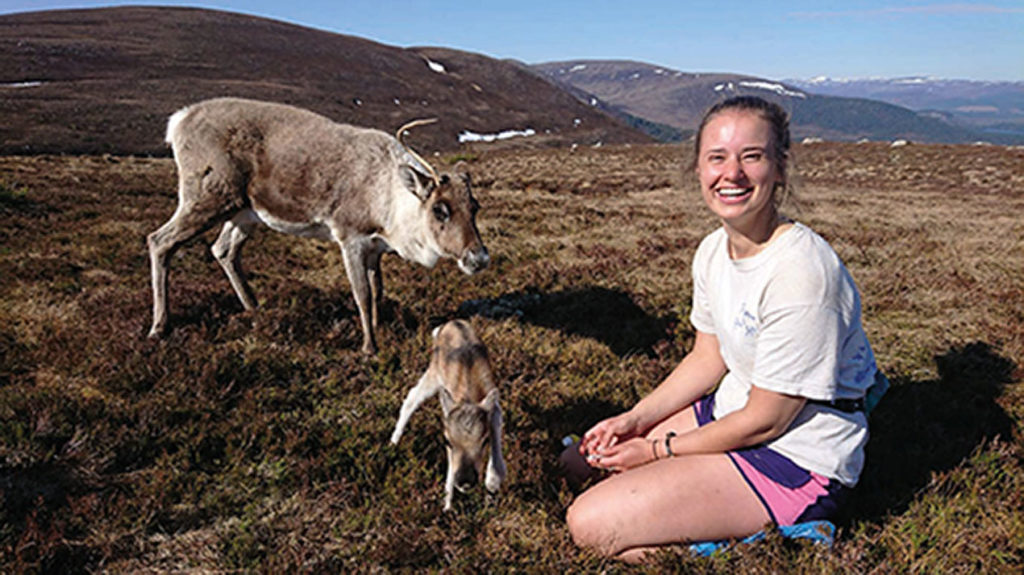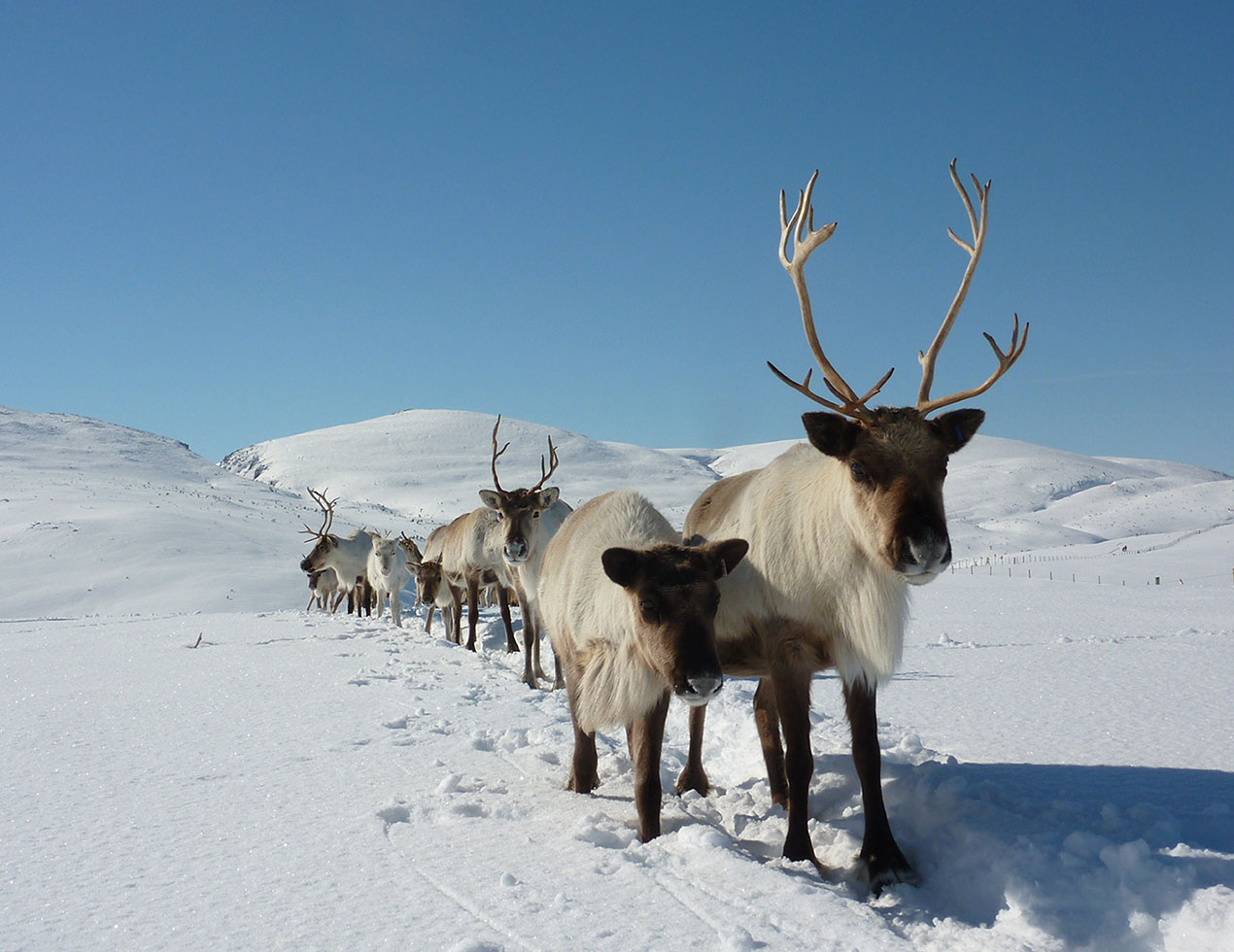Sleigh in their lane
They’re naturally gentle but capable of enduring the harshest conditions – no wonder everyone loves reindeer. Up in Scotland, Lotti Papastavrou Brooks has a dream job with them
As far as occupations go, reindeer herder is among the more unique vocations. Like chocolate consultant or bed tester, it sounds too fantastical to be a real-life job, especially at this time of year when the thought of Santa and his Christmas elves spring to mind.
“Our main source of income is the tours, so the adoption scheme has been a real lifeline through this tough year.”
“People are often surprised because it’s not a normal job title, but then a lot of people don’t know there’s reindeer in the UK,” says Lotti Papastavrou Brooks, 23, who works at the Cairngorm Reindeer Centre in Glenmore village near Aviemore.
Here, high on the Scottish mountains of the Cairngorms National Park, 150 reindeer, ranging from six-month-old Chickpea to 17-year-old Fonn, roam the rugged landscape as their predecessors have.
We might associate the famous antlered deer with the Arctic, but records show wild reindeer roamed the British Isles until around 800 years ago, when they’re believed to have died out due to climate change and over-hunting.
It was a Swedish reindeer herder by the name of Mikel Utsi who reintroduced them to the region in 1952 after he and his wife Dr Ethel Lindgren honeymooned in the area.
To the only place in the UK that’s got a sub-arctic eco-system, which means they can free roam and find their own food, Utsi brought eight reindeer – two bulls, five cows and one castrated male – over from Sweden and the herd grew from there.
In post-war Britain, he presumed reindeer would provide a much-needed meat source as rationing was still rife, but Utsi hadn’t factored in the British public’s sentimental attachment to these docile animals.
“It became clear to him pretty quickly Brits didn’t want to eat a reindeer,” says Papastavrou Brooks. “They’ve become associated with Rudolph and nobody wants to eat Rudolph. None of the other reindeer herding people throughout the world can understand why we don’t eat them because it’s a very good, ethical meat, but then we run an adoption scheme here, so it’s never been in line to meet your reindeer and then eat your reindeer.”
Instead Utsi began running tours so people could get up close to the reindeer and learn more about these delightful animals. The popular tours continue to this day, with the centre now run by Alan and Elizabeth “Tilly” Smith.
Like so many businesses reliant on the public, the reindeer centre has endured a challenging year due to Covid rules and restrictions. It was closed to the public during lockdown and the herders have had to take smaller tour groups since they reopened in July.
“Our main source of income is the tours, so the adoption scheme has been a real lifeline through this tough year,” says Papastavrou Brooks, who volunteered at the centre as a teenager and became one of 10 full-time reindeer herders after leaving university last year. “People can either adopt a single reindeer or the whole herd. It’s a really personal adoption scheme as people receive newsletters written by the reindeer herders to let them know what a particular reindeer, or the herd, has been up to. It’s part of our job, as well as being up in the hills, and we make an effort for people to see their reindeer if they come and visit.
“‘First thing in the morning, we’ll go up to where the reindeer are, feed them and check everything’s okay. It’s easy to tell if a reindeer isn’t feeling very well as they’re off their food. In general, they’re greedy animals, so if any of them aren’t keen on eating, or missing from the group, that’s a key sign they might be unwell, and we can give them any veterinary care they need.”

A few herders also live onsite so they’re on hand in case of an emergency.
“It’s pretty rare, and not usually anything traumatic. There’s one road that goes through the Cairngorms, so occasionally we’ll get a call to say the reindeer are on it. Fortunately, it’s not a quick road and people usually stop to take photos, but we’ll try and move the reindeer on so they don’t cause a traffic jam.”
She says it’s difficult not to get attached to particular characters.
“You definitely get the ones that tug at your heart strings. I might be a bit biased, but I do think baby reindeer are the absolute cutest and this was the first year I’d worked through the calving season.
“I fell in love with the very first calf that was born, who we named Holy Moley because she fell into a hole and we had to rescue her when she was a couple of days old. Normally, we name them around a theme. This year it was beans, peas and seeds, so Chickpea, Jellybean, Mangetout and so on. We’ve named them after cheese in the past, ancient civilisations, European cities. It helps us pick names and also know what year they were born.”
There should now be a big group of pregnant females ready to calf in the spring following a successful rutting season in early autumn.
“Once the rutting season is over, the males actually lose their antlers as they’re incredibly heavy, up to 10kg, which means the females are the only deer with antlers in the winter months. They’ll lose their antlers in the spring at the same time they calf.”
Nothing is left to chance during the mating season.
“We do some serious matchmaking and control everything very carefully. We have a big hill enclosure, around 1,200 acres, which we can divide into four sections, and then we’ll have three different bulls with a group of females he’s not related to in each.
“We’ve got the family records all the way back to the first eight reindeer and we keep that really carefully. It might sound a lot, but 150 reindeer isn’t that many in terms of genetics, so we have to bring new reindeer over from Scandinavia to make sure there isn’t
any inbreeding.”
This year’s calves are being trained how to wear a halter, “which makes it easier if you need to catch them to give them any vaccinations or take their temperature or need to move them”.
The herders are also training the three and four-year-old reindeer how to pull a sleigh on wheels. “We’ll put them next to an older, more experienced reindeer and they’ll just copy them, so really, we let the other reindeer do the teaching.
“They’re Arctic animals, so they try to conserve energy as much as possible, which means they’re very gentle but can be lazy.
“But I love the balance between their gentle temperaments and the wild environment they live in. Reindeer have been domesticated for thousands of years, so they’re very docile and wonderful to work with yet, if we leave them to it, they’re still able to withstand some of the harshest environments on the planet. To me, that’s really special.”
Reindeer have small front teeth perfect for trimming vegetation and lichen. As ruminants they’ll swallow their food and digest, and then bring it back up and chew the cud, like cows do.
Reindeer are the only type of deer whose males, females and calves grow antlers. They grow a new set every year, during the summer months when food’s plentiful, and they’re unique to a reindeer, much like a fingerprint.
A skin called velvet carries the blood supply and nutrients in order for the antlers to form. On average, they’ll grow two to three inches a week over four to five months. The velvet then peels off like a banana skin leaving the solid bone.
If the fierce cold Arctic, reindeer have two coats, a dark thinner coat in the summer months, and a thick winter coat with about 2,000 hairs per square inch of fur to keep them insulted in -70 degrees.

Leave a reply
Your email address will not be published.